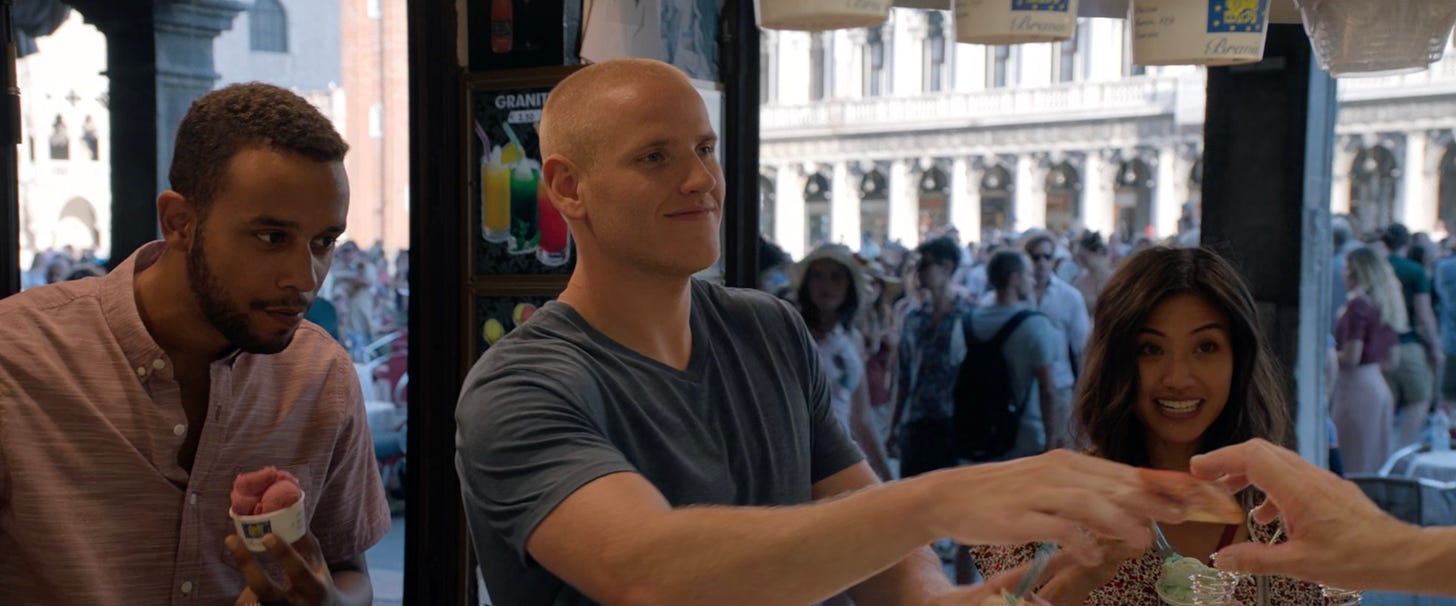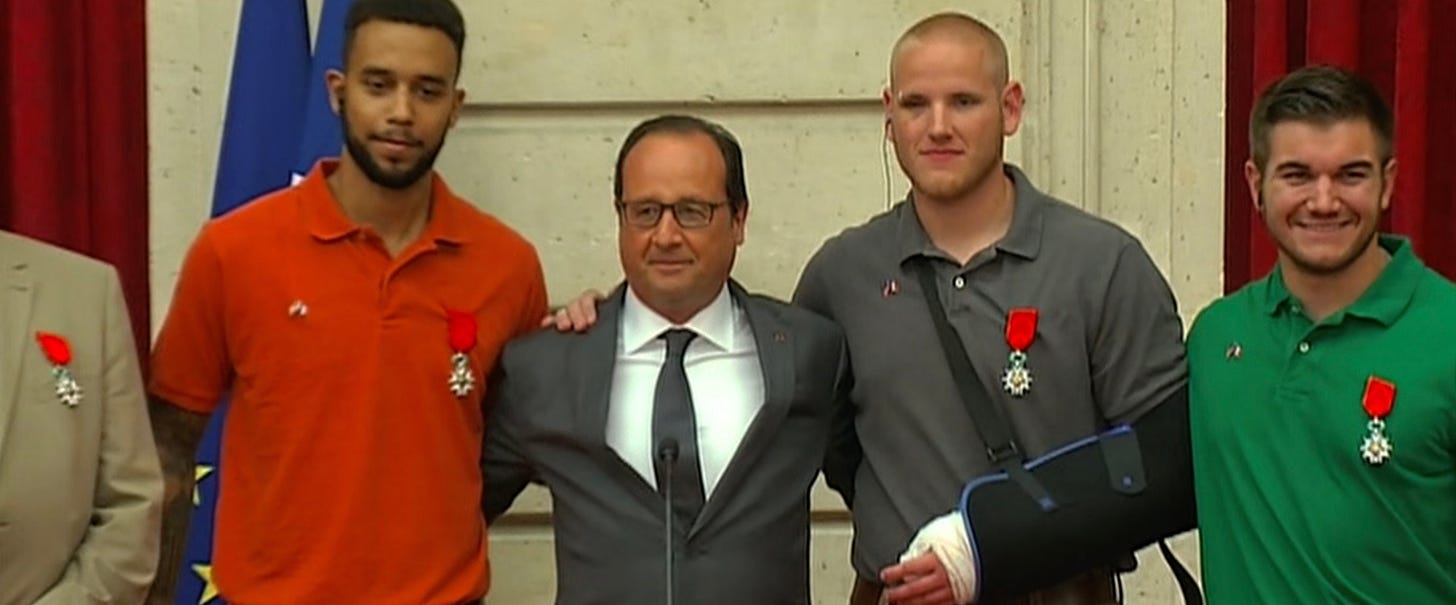Late Eastwood #6: The 15:17 to Paris
A few words about gelato
Welcome to Late Eastwood, my tour through the late work of the still very much alive Clint Eastwood. This is a journey through the prolific director’s films since 2010, a period of his career with which I’m almost wholly unfamiliar. With his new film, Juror #2, on the horizon, I will be combing though the films leading up to it, so I can learn a bit more about what motivates a 94-year-old to keep practicing his art. These posts are usually for paid subscribers only, but for a limited time, I’m making this one free. If you like it, do hit subscribe.
So we’ve come to it at last. The 15:17 to Paris, a movie most normal people probably haven’t thought about in years if they know it at all, but which a certain cadre of Film Twitter types, friends of mine, have sworn up and down is a great, near-experimental masterpiece of contemporary cinema.
They’re right.
The 15:17 to Paris follows Eastwood down the path of subdued naturalism toward meta interrogation of form. He signposts this with the decision to cast the real-life Spencer Stone, Anthony Sadler, and Alek Skarlatos as themselves in the movie about their heroic actions stopping a gunman from taking over a train and committing a massacre. The movie came out in 2018, not even three full years after the incident, in which they also saved the life of a man who’d been shot by the attacker. Sully painted a humble portrait of heroicism, and The 15:17 to Paris is absolutely steeped in humility.
Going into the movie, I’d heard tell, about its scenes of backpacking through Europe, eating gelato, all that. What I wasn’t prepared for was its straightforward depiction of its heroes as just some normal guys. And I mean normal, as in, average, unexceptional. In Sully, you have a person of genuine accomplishment. In other Eastwood films that interrogate heroism, the same is true, from William Munny’s storied career as an outlaw in Unforgiven, to Chris Kyle’s mountain of dead Iraqis in American Sniper, these are exceptional people in important ways. Not so with Stone, Sadler, or Skarlatos. The only exceptional thing about them is that one heroic act, and Eastwood is only tangentially interested in that act. The context is what he’s after.
I’m sure it’s been written about before, but nobody shoots contemporary America quite like Eastwood. His is the world of the “real American,” a silly contrivance, but also true, in that his films are set where real people live. This isn’t an urban-rural divide thing. It’s a subruban strip mall thing. It’s working at a smoothie shop and talking to the Air Force recruiter set up in the parking lot. It’s Christian elementary schools and it’s woodclad basements and it’s beige dining halls. This is an ugly America, aesthetically. Uninspired and uninspiring. It’s also instantly recognizable, a presentation of the everyday spaces North Americans regularly find ourselves in. Dulling to the spirit, and yet people live fully, complex, beautiful lives amid the wasteland. The 15:17 to Paris is about those lives.
I remember when the attack on the Thalys train happened, but only vaguely. I remember that Stone and Skarlatos were noted for their military service. In fact, in my lack of attention, I assumed all three were service members. It’s just the two, though, and neither had remarkable careers. Skarlatos was in the Army National Guard, while Stone, who serves as the film’s closest thing to a lead character, joined the Air Force. His intention was to become a pararecuer so that he could, in his words in the film, “go to war and save lives.” (That’s that American Sniper logic rearing its head, but we won’t get into it.) Turns out he’s got problems with depth perception and can’t be a pararescuer, so he gets shunted to taining for another unit and flunks out of that. He ends up a grunt, basically. As does Skarlatos. In a video call with each other, they both complain about their situation. They enlisted to really do something. To be heroes. Reality intervened.
After an opening scene setting up the attack, the film jumps back to Stone, Sadler, and Skarlatos as troublemakers in elementary school. Nothing particularly big happens. That continues to be true as the trio grow up, become teenagers and then college-age guys amounting to not all that much. Then they go travelling through Europe. Again, not much incident. They go from city to city, touring around, meeting people, eating food, clubbing, getting told off by a German tour guide for being dumb Americans who don’t even know where Hitler shot himself. You know. A European vacation. The magic of this whole section of the movie—indeed the movie as a whole—comes from the three guys playing themselves. They’re bad actors, which lends a unique authenticity bound up in the awkwardness of being and of performing. You get the feeling during their vacation that they’re genuinely enjoying reliving the trip, experiencing it anew while attempting to recreate the sorts of things that actually happened. Like spending a few minutes deciding what flavour of gelato to go with. Reality feels as though it’s busting right out of the screen, unlike almost any movie I’ve ever seen, certainly among mainstream, Hollywood movies.
Then there’s the attack itself, which in now typical late Eastwood style is rendered with economical precision. Eastwood is nothing if not a great director of action. Not like big action sequences, like car chases or something, but very literaly action, as in movement in the frame. He shoots and cuts with such simple clarity, and with a remove suggesting objectivity, or at least matter-of-factness. It’s a gripping sequence, all the more so because it doesn’t bother with exaggeration. The gunman emerges, Stone tackles him, can’t quite get him subdued and is sliced with a knife, but finally, with the help of his friends and others, has him pinned and knocks him out with a chokehold he learned in training. Then he uses his training to help the man who was shot. And that’s about it. They get off the train. There’s no big celebration. There’s no euphoria. Stone, being take away in a wheelchair, doesn’t even seem all that happy. And why should he? It’s a traumatic incident he just went through, even as the hero.
The movie ends with a long scene that is at once baffling and incredible. The trio receive the French Legion of Honour from President François Hollande. A typical scene in a movie like this, except that it goes on for like five minutes, really letting you sit in it. And what you get in the scene is a recreation of the event, starring the three guys playing themselves, with a stand-in for the back of Hollande’s head, intercut with actual footage of Hollande delivering his remarks. Then, in the most incredible moment of all, the trio join Hollande on the screen. That’s the trio from a couple years earlier, of course, and you can just barely tell. Recreation and reality merge.
The 15:17 to Paris is such an unusual movie. A Hollywood movie about the mundanity of life, and the arbitrary circumstances that set the stage for heroic acts. Stone wonders at one point in the film whether he’s fated toward something, perhaps something greater. When he charges to take down that attacker on the train, there’s not actually much “greater” going on. It’s just another moment on this tour through Europe, only it’s a moment that demands action, and the only thing separating Stone from most others is that he was there and he decided to do something. That, to Eastwood, is true heroics and the true measure of humanity. It’s all in the doing. And once the deed is done, life continues in its mundane way. Even when you go to Hollywood and make a movie about yourself, you’re still just you, living your life with all the same joys and disappointments, sometimes even living them over again.











